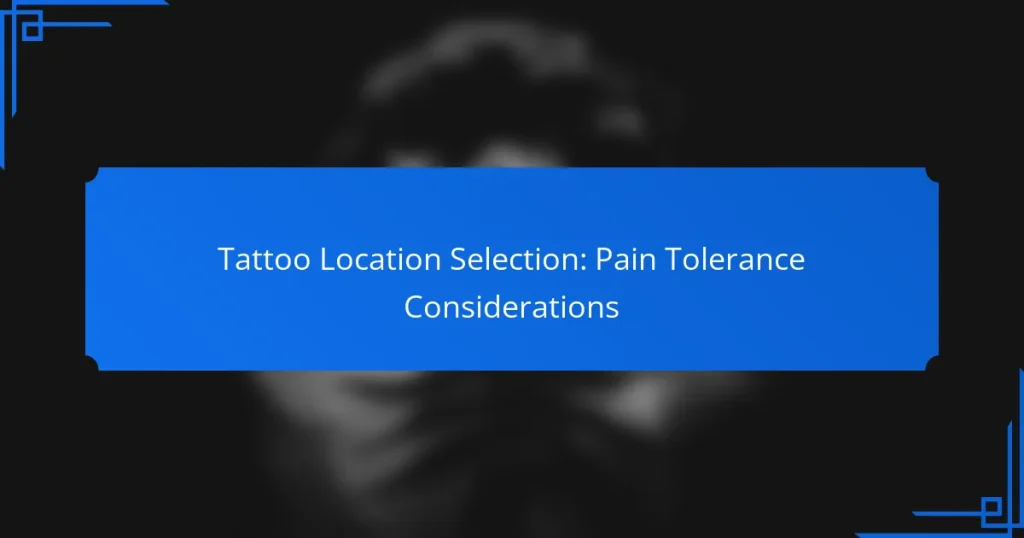When selecting a tattoo location, it’s essential to consider pain tolerance, as sensitivity varies significantly across the body. Areas with thinner skin and higher concentrations of nerve endings, such as the ribcage and spine, are generally more painful during the tattooing process. By understanding these factors, you can better prepare for your tattoo experience and manage your expectations regarding discomfort.

What Are the Most Painful Tattoo Locations?
The most painful tattoo locations are typically those with less flesh and more nerve endings. Areas like the ribcage, spine, elbows, knees, and armpits are known for their heightened sensitivity during tattooing.
Ribcage
The ribcage is notorious for being one of the most painful areas to get tattooed. The skin is thin, and the proximity to bones and nerves can amplify discomfort. Pain levels can vary significantly based on individual tolerance, but many report it as a sharp, intense sensation.
When considering a ribcage tattoo, it’s advisable to prepare mentally for a higher pain threshold. Taking breaks during the session can help manage discomfort, and discussing pain management options with your artist is recommended.
Spine
The spine is another highly sensitive area due to the numerous nerve endings and the thin layer of skin over the vertebrae. Many people describe the pain as a deep, radiating sensation that can be quite overwhelming. The intensity can vary along different parts of the spine.
For those opting for a spine tattoo, it’s helpful to stay relaxed and breathe deeply during the process. Some artists suggest starting with smaller designs to gauge pain tolerance before committing to larger pieces.
Elbows
Elbows are particularly painful due to the lack of flesh and the presence of many nerve endings. The skin here is thin and sensitive, making the tattooing process quite uncomfortable. Pain can be sharp and quick, often described as a stinging sensation.
If you’re considering an elbow tattoo, think about the design’s placement carefully. Opting for a design that doesn’t wrap around the joint can minimize discomfort. Also, be prepared for a quick session, as many artists can complete elbow tattoos relatively fast.
Knees
Knees are similar to elbows in terms of sensitivity, with thin skin and numerous nerves. The pain can be intense, especially around the kneecap, where the skin is taut and close to the bone. Many find the sensation to be a mix of sharp and throbbing.
To ease the experience, consider getting a knee tattoo when you’re well-rested and relaxed. Discussing pain management techniques with your tattoo artist can also help make the process more bearable.
Armpits
The armpit area is often regarded as one of the most painful spots for a tattoo. The skin is delicate, and the presence of many nerve endings can lead to extreme discomfort. Pain in this area can feel like a sharp, overwhelming sensation.
If you’re set on an armpit tattoo, be prepared for a potentially longer session due to the need for precision and care. It’s advisable to have a clear design in mind and to communicate openly with your artist about your pain tolerance and any concerns you may have.

How Does Pain Tolerance Vary by Tattoo Location?
Pain tolerance for tattoos can significantly differ based on the location on the body. Areas with thinner skin, higher nerve density, or less muscle and fat cushioning tend to be more painful during the tattooing process.
Skin Thickness
Skin thickness plays a crucial role in pain perception during tattooing. Thinner skin, such as that found on the inner arms or wrists, is generally more sensitive and can lead to a sharper pain sensation. In contrast, thicker skin areas, like the back or thighs, may provide a more tolerable experience due to the added cushioning.
Nerve Endings Density
The density of nerve endings in a given area greatly influences pain levels during tattooing. Regions with a high concentration of nerve endings, such as the ribs and spine, tend to be more painful. Conversely, areas with fewer nerve endings, like the outer thigh, often result in a less intense sensation.
Muscle and Fat Distribution
The distribution of muscle and fat can affect how much pain is felt during a tattoo session. Areas with more muscle or fat, such as the upper arm or calf, can absorb some of the pain, making the experience more bearable. On the other hand, bony areas like the elbows or knees provide little cushioning, leading to increased discomfort.

What Factors Influence Pain During Tattooing?
Several factors can significantly affect the pain experienced during tattooing, including individual pain tolerance, the size and detail of the tattoo, and the artist’s technique. Understanding these elements can help you prepare for the tattooing process and manage your expectations regarding discomfort.
Individual Pain Threshold
Each person has a unique pain threshold, which can vary widely based on genetics, mental state, and past experiences. Some individuals may find certain areas of their body more sensitive than others, leading to different pain levels during the tattooing process.
To gauge your pain tolerance, consider previous experiences with pain, such as getting piercings or undergoing medical procedures. If you know you have a low tolerance, discuss this with your tattoo artist beforehand to explore options for pain management.
Tattoo Size and Detail
The size and intricacy of a tattoo can influence the duration and intensity of pain. Larger tattoos or those with intricate designs typically require more time and can lead to prolonged discomfort. Smaller, simpler tattoos may be completed quickly, resulting in less overall pain.
When choosing a tattoo, consider how much detail you want and how long you are willing to endure discomfort. If you’re concerned about pain, opting for a smaller design may be a more manageable choice.
Artist Technique
The technique employed by the tattoo artist plays a crucial role in the pain experienced during the session. Experienced artists often have a lighter touch and can work more efficiently, reducing the duration of discomfort. Conversely, less experienced artists may apply more pressure or take longer to complete the tattoo.
Before committing to an artist, review their portfolio and ask about their approach to tattooing. A skilled artist can help minimize pain through their technique and ensure a more comfortable experience overall.

How to Choose a Tattoo Location Based on Pain Tolerance?
Selecting a tattoo location with consideration for pain tolerance is crucial for a comfortable experience. Areas with more muscle and fat tend to be less painful, while spots over bone or with less flesh can be more sensitive.
Assess Personal Pain Tolerance
Understanding your own pain tolerance is the first step in choosing a tattoo location. Everyone experiences pain differently, so consider past experiences with pain, such as injuries or medical procedures, to gauge your comfort level.
To assess your pain tolerance, you might try pinching yourself in various areas or using a pain scale from 1 to 10 to rate discomfort. This can help you identify which areas might be more tolerable for a tattoo.
Consult with Tattoo Artists
Professional tattoo artists can provide valuable insights into pain levels associated with different body areas. They have experience with clients and can share which locations tend to be more or less painful based on their observations.
Don’t hesitate to ask your artist about their recommendations based on your pain tolerance and the design you want. They may suggest locations that balance visibility and comfort effectively.
Consider Tattoo Size and Complexity
The size and complexity of the tattoo can influence pain levels during the process. Larger tattoos or those with intricate details may require longer sessions, which can increase discomfort over time.
For a more manageable experience, consider starting with a smaller, simpler design in a less painful area. This approach allows you to gauge your pain tolerance without committing to a lengthy session in a sensitive spot.

What Are the Best Practices for Minimizing Pain During a Tattoo?
To minimize pain during a tattoo, consider using numbing creams, staying well-hydrated, and choosing the right time for your appointment. These practices can significantly enhance your comfort and overall experience.
Use of Numbing Creams
Numbing creams can effectively reduce pain during tattooing by temporarily blocking nerve signals in the skin. Look for products containing lidocaine, which is commonly used for this purpose. Apply the cream about 30 minutes before your session for optimal results.
However, be cautious with the amount you use, as excessive application may lead to skin irritation. Always consult with your tattoo artist to ensure the cream is suitable for your skin type and the tattooing process.
Staying Hydrated
Staying hydrated before and during your tattoo session can help minimize discomfort. Proper hydration keeps your skin supple and can make the tattooing process smoother, potentially reducing pain levels. Aim to drink plenty of water in the days leading up to your appointment.
Avoid alcohol and caffeine on the day of your tattoo, as these can dehydrate you and increase sensitivity. A well-hydrated body is better equipped to handle the stress of the tattooing process.
Choosing the Right Time
Selecting the right time for your tattoo can influence your pain tolerance. Consider scheduling your appointment when you are well-rested and in a calm state of mind. Avoid times of high stress or fatigue, as these conditions can amplify pain perception.
Additionally, some people find that getting tattooed during cooler parts of the day, such as early morning or late afternoon, can help them feel more comfortable. Listen to your body and choose a time that works best for you.

What Are the Psychological Aspects of Tattoo Pain?
The psychological aspects of tattoo pain involve how an individual’s mindset and emotional state can influence their perception of discomfort during the tattooing process. Understanding these factors can help individuals prepare mentally, potentially reducing the overall experience of pain.
Mindset and Relaxation Techniques
A positive mindset can significantly impact how one experiences tattoo pain. Approaching the session with a calm and confident attitude can help mitigate anxiety, which often amplifies the sensation of pain. Techniques such as visualization, where one imagines a serene environment, can be beneficial.
Relaxation techniques, such as deep breathing exercises or mindfulness meditation, can also play a crucial role. Practicing these methods before and during the tattooing process can help maintain a sense of calm, making the experience more manageable. For instance, taking slow, deep breaths can lower heart rate and reduce tension.
Additionally, consider using distraction methods during the tattooing session. Listening to music, engaging in conversation with the tattoo artist, or focusing on a specific object in the room can divert attention from the pain, making it feel less intense. These strategies can be particularly effective for first-time tattoo recipients.


